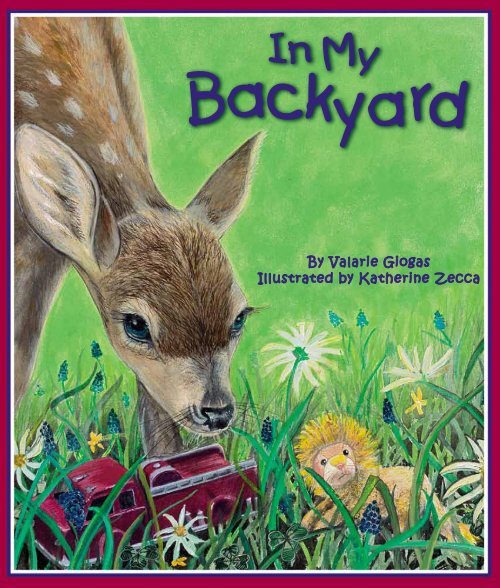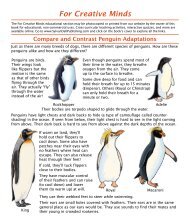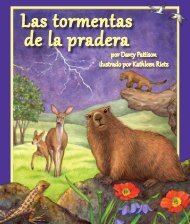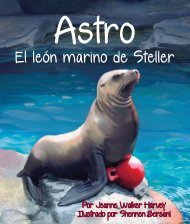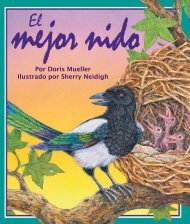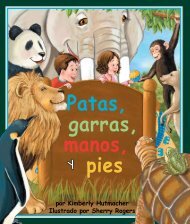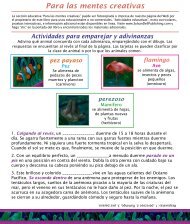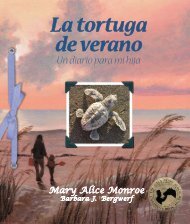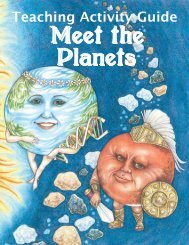By Valarie Giogas Illustrated by Katherine Zecca - Sylvan Dell ...
By Valarie Giogas Illustrated by Katherine Zecca - Sylvan Dell ...
By Valarie Giogas Illustrated by Katherine Zecca - Sylvan Dell ...
You also want an ePaper? Increase the reach of your titles
YUMPU automatically turns print PDFs into web optimized ePapers that Google loves.
<strong>By</strong> <strong>Valarie</strong> <strong>Giogas</strong><br />
<strong>Illustrated</strong> <strong>by</strong> <strong>Katherine</strong> <strong>Zecca</strong>
Ba<strong>by</strong> dogs are puppies and they belong to<br />
a litter, but what are ba<strong>by</strong> skunks called and<br />
what is the name of their group? This clever,<br />
rhythmic story tells us just that! Counting<br />
from one to ten, the story introduces familiar<br />
backyard animals <strong>by</strong> ba<strong>by</strong> and family group<br />
names.<br />
Free online resources and support for the book at<br />
www.<strong>Sylvan</strong><strong>Dell</strong>Publishing.com include:<br />
• For Creative Minds as seen in the book:<br />
° Animal counting and fun fact cards:<br />
- Deer<br />
- Moles<br />
- Porcupines - Skunks<br />
- Squirrels - Snakes<br />
- Raccoons - Foxes<br />
- Rabbits - Grasshoppers<br />
° Animal signs all around you<br />
° Caring for wildlife around you<br />
° What to do if you find an injured animal<br />
• Teaching Activities:<br />
° Before and After ° Math<br />
Reading Questions ° Geography<br />
° Language Arts ° Coloring pages<br />
° Science<br />
• Interactive Quizzes: Reading Comprehension,<br />
For Creative Minds and Math<br />
• English and Spanish audio<br />
• Learning Links (subject related websites)<br />
• Aligned to National & State Science &<br />
Math Standards<br />
• Accelerated Reader, Lexile, & Reading<br />
Counts levels<br />
Thanks to Sherry Crawley, Director of Education<br />
at Zoo Atlanta and to Helen Fischel, Associate<br />
Director of Education at the Delaware Nature<br />
Society for verifying the accuracy of the information in<br />
the book. And thanks to Caryl Widdowson of<br />
Safe & Sound Wildlife Rehabilitation (ME) for<br />
her help with the rehabilitation section.<br />
<strong>Valarie</strong> <strong>Giogas</strong> (pronounced JOE-gus) has been<br />
writing for children ever since she discovered<br />
that she could combine her love for children’s<br />
literature with her passion for writing. The<br />
idea for In My Backyard began when her son was<br />
in preschool. They always drove <strong>by</strong> a gaggle of<br />
geese and he would giggle when she told him<br />
the group name. When the geese had goslings,<br />
the idea for this book was affirmed. A member<br />
of the Society for Children’s Book Writers and<br />
Illustrators, <strong>Valarie</strong> has also written articles for<br />
Hopscotch Magazine. <strong>Valarie</strong> and her family<br />
live in a suburb of Boston.<br />
<strong>Katherine</strong> <strong>Zecca</strong> loves to illustrate animals of all<br />
kinds. In addition to In My Backyard, she wrote<br />
and illustrated Puffin’s Year and illustrated<br />
River Song with the Banana Slug String Band<br />
and Why Puppies Do That. As a scientific illustrator,<br />
she has also created award-winning art for<br />
NOAA and the National Zoo.<br />
<strong>Valarie</strong> <strong>Giogas</strong><br />
<strong>Katherine</strong> <strong>Zecca</strong><br />
<strong>By</strong> <strong>Valarie</strong> <strong>Giogas</strong><br />
<strong>Illustrated</strong> <strong>by</strong> <strong>Katherine</strong> <strong>Zecca</strong>
To the men in my life, CG, JAG and RDG—VG<br />
To my sister, Cyndi—KZ<br />
Thanks to Sherry Crawley,<br />
Director of Education at Zoo Atlanta<br />
and to Helen Fischel,<br />
Associate Director of Education at the Delaware Nature Society<br />
for verifying the accuracy of the information in the book.<br />
And thanks to Caryl Widdowson<br />
of Safe & Sound Wildlife Rehabilitation (ME) for her help.
In my backyard I can see<br />
groups of ba<strong>by</strong> animals<br />
all around me.<br />
They creep, they crawl, they run, and hide.<br />
They munch, they crunch, they sleep outside.
In my backyard I can see<br />
one doe’s fawn<br />
peeking at me.<br />
He sees me through the leaves and brush,<br />
then runs to mama in a rush.
For Creative Minds<br />
Directions: Photocopy or download the following pages from the In My Backyard<br />
homepage at www.<strong>Sylvan</strong><strong>Dell</strong>Publishing.com onto heavy or regular paper. If using as<br />
a memory game, make two copies. Cut each page into cards and have the children<br />
put into numerical order. Please do not write in or cut the book.<br />
5<br />
6<br />
Rabbits “talk” to each other through<br />
smell and touch.<br />
Moles have bad eyesight, but they can<br />
hear insects from a distance and have a<br />
good sense of smell.<br />
2<br />
7 8<br />
Deer have an excellent sense of smell<br />
as well as good hearing and eyesight.<br />
Porcupine pups are born with soft quills<br />
that become hard within an hour.<br />
Skunks are only born in the spring. The<br />
kits are almost blind and don’t have<br />
fur.<br />
Snakes that are born alive are called<br />
snakelets. If they come from eggs, they<br />
are called hatchlings. They smell <strong>by</strong><br />
flicking their tongues in and out.<br />
3 4<br />
9<br />
Squirrels gather and bury nuts for<br />
winter. If the nuts are not eaten, they<br />
may grow into trees!<br />
Raccoons are excellent climbers and<br />
can climb down a tree head first.<br />
Foxes are good tree climbers. Many<br />
are good swimmers and can run up to<br />
twenty miles per hour.<br />
Grasshopper nymphs look like little<br />
adult grasshoppers without wings.
a fawn is a<br />
ba<strong>by</strong> deer<br />
6<br />
pups are<br />
ba<strong>by</strong> moles<br />
2<br />
pups are ba<strong>by</strong><br />
porcupines<br />
7<br />
kits are<br />
ba<strong>by</strong> skunks<br />
3<br />
pups are<br />
ba<strong>by</strong> squirrels<br />
8<br />
hatchlings are<br />
ba<strong>by</strong> snakes<br />
4<br />
cubs are<br />
ba<strong>by</strong> raccoons<br />
9<br />
pups are<br />
ba<strong>by</strong> foxes<br />
5<br />
bunnies are<br />
ba<strong>by</strong> rabbits<br />
nymphs<br />
are ba<strong>by</strong><br />
grasshoppers
Animal Signs All Around You<br />
Animals leave “signs” that show they were there. Find a nature spot: your backyard,a<br />
park, or a nature center. See how many “animal signs” you can find. Here are just a<br />
few:<br />
scat (poop)<br />
pieces of homes<br />
(bird nests, spider webs, etc.)<br />
broken or chewed plants<br />
What to Do If You Find an Injured Animal<br />
Wildlife rehabilitators are people who care for injured wild<br />
animals and nurse them back to health. It is always a good<br />
idea to look up and find a wildlife rehabilitator in your area<br />
before you need one! Check online, look in the phone book,<br />
or ask a veterinarian.<br />
If the animal is alert and big enough to harm you, call<br />
the wildlife rehabilitator or your local animal control. Let<br />
professionals help the animal.<br />
If the animal is small, of no danger to you, and looks<br />
like it may be nursed back to health, try to get it to<br />
a rehabilitator:<br />
chewed pinecones, nuts<br />
or tree bark<br />
tracks<br />
Caring For Wildlife Around You<br />
feathers, shells, or bones<br />
Some or all of the animals mentioned in this book may live or pass through your<br />
yard, even if you never see them! What can you do to protect wild animals?<br />
• Keep pets inside.<br />
• Please pick up your trash—especially plastic. Wild animals may eat the<br />
trash and get sick.<br />
• Don’t touch any wild animals; they are just that—wild!<br />
• Don’t try to keep them or to make them pets.<br />
• Feed and watch birds but don’t feed other wild animals.<br />
• Wear gloves or wrap the animal in a towel so<br />
that you don’t touch it. Remember that the<br />
animal, if conscious, will be scared and may try<br />
to claw or bite. An unconscious animal could<br />
wake up any time.<br />
• If it is cold, place a heating pad on low or a<br />
ziplock bag of very warm water in part of a box<br />
(so the animal can move away from the heat if<br />
necessary) and put a towel or blanket on top<br />
of the heat source. Place the injured animal on<br />
top of the warm side, on top of the towel or<br />
blanket.<br />
• Tightly cover the box, but please make sure<br />
that there are ventilation holes for the animal<br />
to breathe.<br />
• Do NOT try to feed the animal.<br />
• If you think an animal is orphaned, leave it<br />
alone until you are positive that the mother is<br />
not returning. It is normal for animal parents to<br />
leave to get food, sometimes for several hours<br />
or even all day. If, however, you know that the<br />
mother is dead, call a wildlife rehabilitator or<br />
wildlife expert to get the animal.
<strong>Giogas</strong>, <strong>Valarie</strong>.<br />
In my backyard / <strong>by</strong> <strong>Valarie</strong> <strong>Giogas</strong> ; illustrated <strong>by</strong> <strong>Katherine</strong> <strong>Zecca</strong>.<br />
p. : col. ill. ; cm.<br />
Includes “For Creative Minds” section with animal facts<br />
memory game and information on caring for wildlife.<br />
978-0-97774-2318 English hardcover ISBN<br />
978-1-60718-8711 English paperback ISBN<br />
978-1-60718-0197 English eBook downloadable ISBN<br />
978-1-93435-9549 Spanish eBook downloadable ISBN<br />
978-1-60718-2658 Interactive, read-aloud eBook featuring selectable<br />
English and Spanish text and audio (web and iPad/tablet based) ISBN<br />
1. Animals--Infancy--Juvenile literature. 2. Counting--Juvenile literature.<br />
3. Animals--Infancy. 4. Counting. 5. Stories in rhyme.<br />
I. <strong>Zecca</strong>, <strong>Katherine</strong>. II. Title.<br />
QL751.5 .G56 2007<br />
591.5 2006940900<br />
Text Copyright © 2007 <strong>by</strong> <strong>Valarie</strong> <strong>Giogas</strong><br />
Illustration Copyright © 2007 <strong>by</strong> <strong>Katherine</strong> <strong>Zecca</strong><br />
Text layout and design, pencil sketches <strong>by</strong> Lisa Downey<br />
The “For Creative Minds” educational section may be<br />
copied <strong>by</strong> the owner for personal use or <strong>by</strong> educators<br />
using copies in classroom settings.<br />
<strong>Sylvan</strong> <strong>Dell</strong> Publishing<br />
Mt. Pleasant, SC 29464<br />
Includes 4 pages of<br />
learning activities.<br />
Look for more free activities<br />
online at<br />
www.<strong>Sylvan</strong><strong>Dell</strong>Publishing.com


